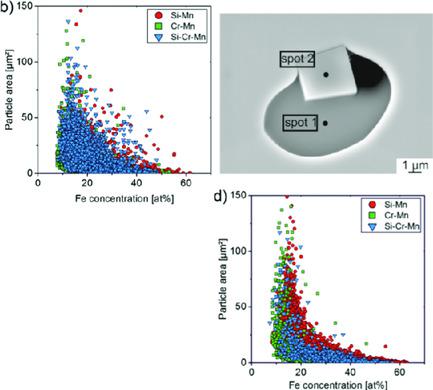当前位置:
X-MOL 学术
›
Adv. Eng. Mater.
›
论文详情
Our official English website, www.x-mol.net, welcomes your feedback! (Note: you will need to create a separate account there.)
Investigations on Oxide Particles Formed during Sintering of CrMnNi‐Transformation‐Induced Plasticity (TRIP) Steel Powder Metallurgically Materials Using Automatic Feature Analysis
Advanced Engineering Materials ( IF 3.6 ) Pub Date : 2020-11-21 , DOI: 10.1002/adem.202001215 Christian Weigelt 1 , Florian Kerber 1 , Christine Baumgart 2 , Lutz Krüger 2 , Christos G. Aneziris 1
Advanced Engineering Materials ( IF 3.6 ) Pub Date : 2020-11-21 , DOI: 10.1002/adem.202001215 Christian Weigelt 1 , Florian Kerber 1 , Christine Baumgart 2 , Lutz Krüger 2 , Christos G. Aneziris 1
Affiliation

|
The combination of powder metallurgical and ceramics‐derived processing enables the manufacturing of innovative metal components. Using high‐alloyed transformation‐induced plasticity (TRIP) steels facilitates the manufacturing of metal components with outstanding mechanical properties for advanced load applications. The oxygen affinity of some alloying elements promotes the formation of non‐metallic particles during sintering, which deteriorate the mechanical properties. Bulk specimens are prepared from a 17Cr7Mn6Ni‐TRIP steel powder using a ceramics‐derived extrusion process with organic binders at ambient temperature. Processing comprises the thermal binder removal in air and the sintering in pure argon or hydrogen atmospheres. The sintered specimens are analyzed for their amount and composition of non‐metallic particles using scanning electron microscopy (SEM) and energy‐dispersive spectroscopy (EDS). The focus of this article is on the automated particle identification and analysis using an automatic SEM‐EDS‐related device. The automatic feature analysis provides statistical information on the chemistry, size, and morphology. The particles mainly consist of Cr, Mn, Si, and O forming Mn2SiO4 and MnCr2O4. The number of particles mainly depends on the debinding temperature and on the sintering atmosphere. The use of a pure hydrogen sintering atmosphere significantly depresses the formation of MnCr2O4, whereas silicates remain stable under the applied atmospheric and thermal conditions.
中文翻译:

CrMnNi相变诱导塑性粉末冶金材料烧结过程中形成的氧化物粒子的自动特征分析
粉末冶金和陶瓷衍生工艺的结合使创新金属部件的制造成为可能。使用高合金相变诱发塑性(TRIP)钢可以促进具有出色机械性能的金属部件的制造,从而适用于先进的载荷应用。一些合金元素的氧亲合力促进了烧结过程中非金属颗粒的形成,从而降低了机械性能。使用17Cr7Mn6Ni‐TRIP钢粉,在环境温度下,采用陶瓷衍生的挤压工艺,结合有机粘合剂,制备块状试样。加工包括去除空气中的热粘合剂以及在纯氩气或氢气气氛中进行烧结。使用扫描电子显微镜(SEM)和能量色散光谱(EDS)分析烧结样品的非金属颗粒数量和组成。本文的重点是使用自动SEM-EDS相关设备进行自动颗粒识别和分析。自动特征分析提供有关化学,大小和形态的统计信息。颗粒主要由形成Mn的Cr,Mn,Si和O组成2 SiO 4和MnCr 2 O 4。颗粒的数量主要取决于脱脂温度和烧结气氛。纯氢气烧结气氛的使用显着抑制了MnCr 2 O 4的形成,而硅酸盐在所施加的大气和热条件下保持稳定。
更新日期:2020-11-21
中文翻译:

CrMnNi相变诱导塑性粉末冶金材料烧结过程中形成的氧化物粒子的自动特征分析
粉末冶金和陶瓷衍生工艺的结合使创新金属部件的制造成为可能。使用高合金相变诱发塑性(TRIP)钢可以促进具有出色机械性能的金属部件的制造,从而适用于先进的载荷应用。一些合金元素的氧亲合力促进了烧结过程中非金属颗粒的形成,从而降低了机械性能。使用17Cr7Mn6Ni‐TRIP钢粉,在环境温度下,采用陶瓷衍生的挤压工艺,结合有机粘合剂,制备块状试样。加工包括去除空气中的热粘合剂以及在纯氩气或氢气气氛中进行烧结。使用扫描电子显微镜(SEM)和能量色散光谱(EDS)分析烧结样品的非金属颗粒数量和组成。本文的重点是使用自动SEM-EDS相关设备进行自动颗粒识别和分析。自动特征分析提供有关化学,大小和形态的统计信息。颗粒主要由形成Mn的Cr,Mn,Si和O组成2 SiO 4和MnCr 2 O 4。颗粒的数量主要取决于脱脂温度和烧结气氛。纯氢气烧结气氛的使用显着抑制了MnCr 2 O 4的形成,而硅酸盐在所施加的大气和热条件下保持稳定。



























 京公网安备 11010802027423号
京公网安备 11010802027423号